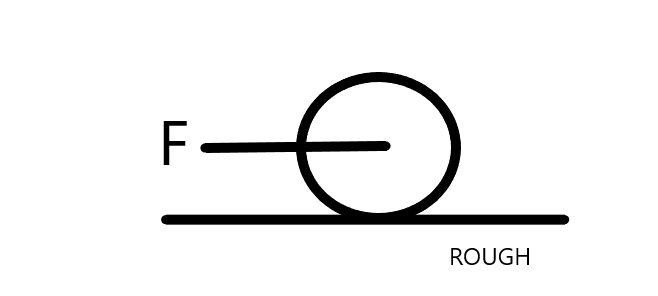I think the body should not move since maximum static friction is greater than the applied force but my book says that it will roll. Also I have read that static friction is independent of the area of contact. Please tell me where am I going wrong?
2 Answers
Suppose you dragged the body without it rotating, like a car skidding to a stop with the brakes on hard. Don't think about the forces yet. Just think about the bottom. It would move forward and slide over the surface.
Now hold it still and rotate it. Rotation makes the bottom surface move backward.
Combine these. Drag it forward at a constant speed, and start rotating it slowly. The bottom has a forward velocity from sliding, but also a small backward velocity from rotating. The result is it slide forward, but more slowly that it would with pure dragging.
Rotate it faster and faster. At some point the forward and backward velocities are equal. The bottom velocity is $0$. At this point, the body is rolling.
Getting back to your question, if the force is less than static friction, the bottom doesn't move. But the body can roll never the less.
-
$\begingroup$ But if the frictional force is greater than the force applied by me (dragging), the body should not move? Did'nt get the answer to my question! $\endgroup$ Commented Nov 17, 2023 at 15:38
-
$\begingroup$ But there must be some torque for the body to roll, is it that the static friction provides the torque and makes the contact point move? Its so confusing.... $\endgroup$ Commented Nov 17, 2023 at 16:11
-
$\begingroup$ A torque is two equal forces that are parallel and in opposite directions. Static friction is in the direction that keeps the bottom from sliding - backward. F is forward. For more about this, see Toppling of a cylinder on a block $\endgroup$ Commented Nov 17, 2023 at 17:19
-
$\begingroup$ But as per my understanding two equal forces that are anti parellel and have different line of action is termed as couple. In the above case, it is the torque provided by frictional force which is responsible for rotation. $\endgroup$ Commented Nov 17, 2023 at 18:54
-
$\begingroup$ Yes. If you dragged the body on frictionless ice, it would slide without rotation. $\endgroup$ Commented Nov 18, 2023 at 0:17
I think the body should not move since static friction is greater than the applied force
That is not possible. Static friction only arises in response to applied forces. A book sitting on a level table has zero static friction. Only when you start applying some other sideways force to it does static friction appear.
Similarly, the friction force on the sphere cannot be greater than the applied force $F$.
If we imagine that for a moment the applied force and the frictional force were identical, then the center of the sphere would not accelerate, but it would begin to rotate since the forces are being applied at different points.
The rotation of the sphere will tend to push the bottom of the sphere backward, and that would reduce the force on the table (and the force of friction that appears). Now that friction is less than the applied force, the sphere accelerates.
(In reality, the sphere acceleration doesn't happen as a separate step, it happens simultaneously. This is just a thought exercise)

